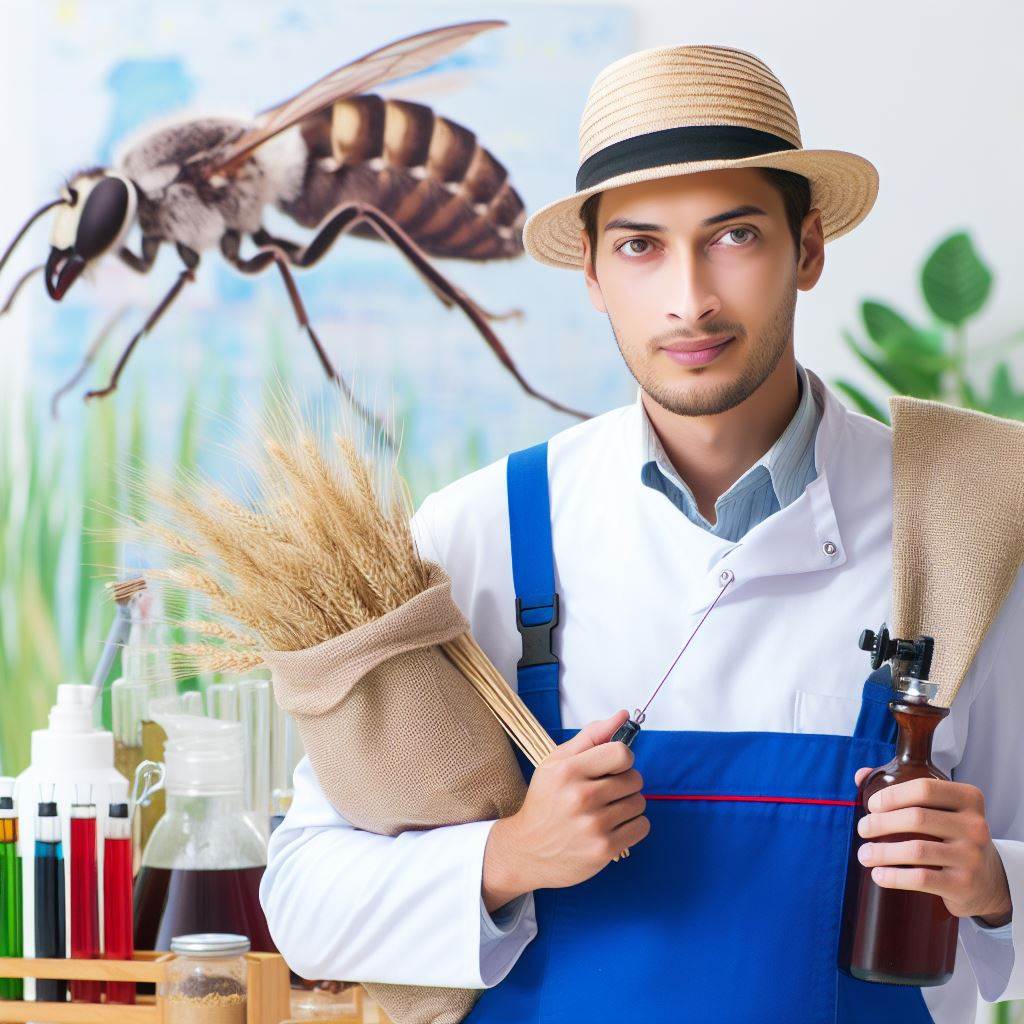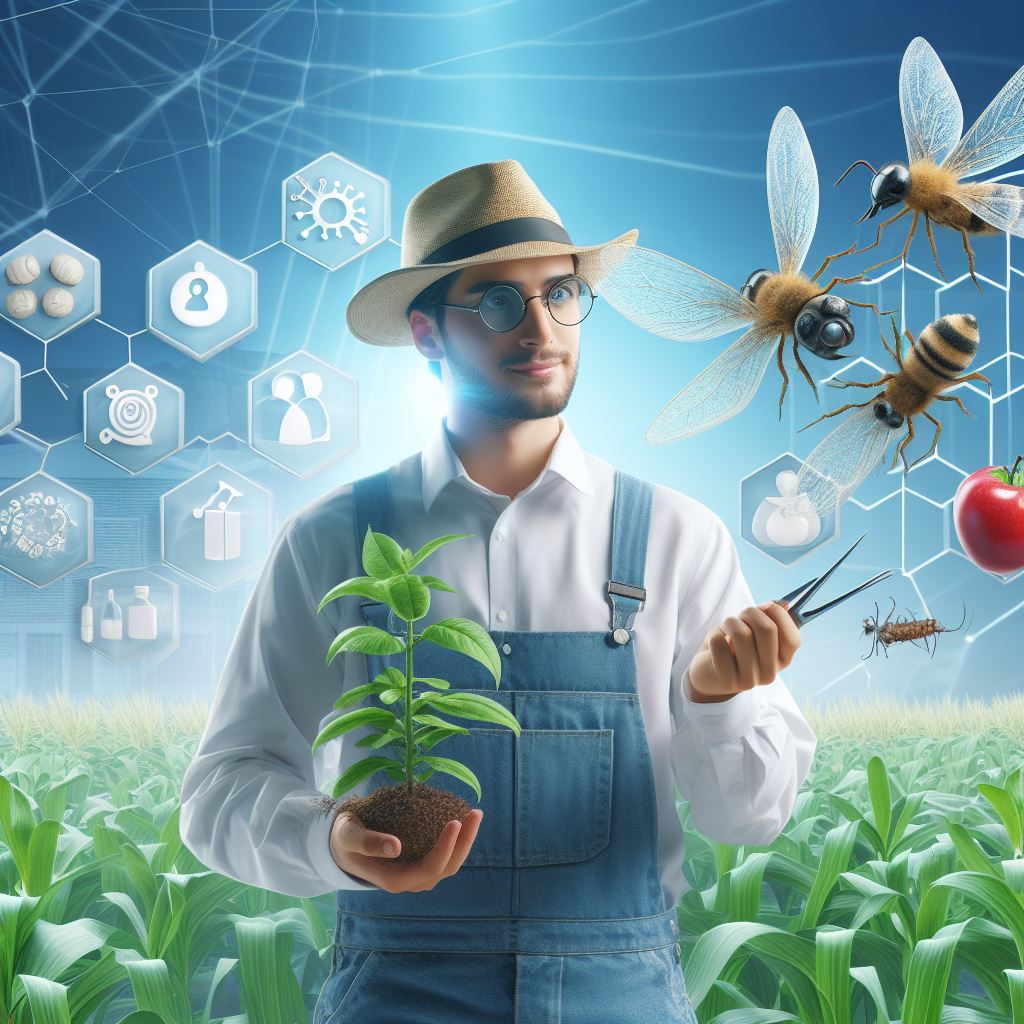Introduction
Pest control is crucial in agriculture to ensure high crop yields and food security.
However, the use of traditional pesticides has negative impacts on the environment and human health.
In the lush tapestry of Earth’s landscapes, the intricate relationships between species form the backbone of thriving ecosystems.
Yet, amidst the verdant beauty lies a perpetual struggle: the battle between pests and the delicate balance of biodiversity.
As humanity endeavors to cultivate sustenance while safeguarding the rich fabric of life, the importance of natural pest control emerges as a beacon of hope and resilience.
This intricate dance of predator and prey, of symbiotic relationships and biological intricacies, not only offers solutions to agricultural challenges but also embodies a profound ethos of interconnectedness with the natural world.
Join us on a journey into the heart of this captivating realm, where the principles of biodiversity serve as our guiding light in the pursuit of sustainable coexistence with our planet’s wondrous biodiversity.
Definition and concept of natural pest control
Explanation of natural pest control
Natural pest control relies on the principle of balance in ecosystems. By maintaining high biodiversity, we ensure that natural enemies of pests are present in sufficient numbers to keep their populations in check.
This approach is based on the understanding that ecosystems are complex webs of interactions and disrupting them can have unintended consequences.
Chemical pesticides, while effective in the short term, can lead to the emergence of pesticide-resistant pests, harm beneficial insects, and contaminate soil and water.
One of the key methods used in natural pest control is biological control. This involves introducing natural enemies of pests into the ecosystem to control their populations.
Ladybugs, for example, are famous for their role in controlling aphids.
By releasing ladybugs into an infested garden, we can harness their voracious appetite for aphids and reduce their numbers naturally.
Another method is the use of insect-repelling plants. Certain plants, such as marigolds, mint, and lavender, naturally repel pests with their strong aromas.
By interplanting these repellent plants with susceptible crops, we can create a natural barrier against pests.
Transform Your Agribusiness
Unlock your farm's potential with expert advice tailored to your needs. Get actionable steps that drive real results.
Get StartedCreating habitats for beneficial insects is also crucial for successful pest control.
By providing diverse and suitable habitats, we attract a range of natural enemies, such as predatory insects and birds, that feed on pests.
This can be achieved by planting native flowering plants, maintaining hedgerows, and incorporating bug hotels into the landscape.
The role of biodiversity in the process
Biodiversity plays a vital role in the success of natural pest control.
When we have a diverse range of plant species in our gardens or farmlands, we attract a variety of insects and other organisms.
Some of these insects will be pests, but many others will be beneficial predators or parasites.
The presence of these natural enemies helps keep pest populations in check, reducing the need for chemical interventions.
Furthermore, biodiversity provides resilience to ecosystems. In the face of environmental disturbances or climate change, diverse ecosystems are better equipped to adapt and recover.
This resilience extends to pest control as well. When a pest outbreak occurs, a diverse ecosystem can quickly respond by increasing the populations of natural enemies, leading to a more sustainable and long-term solution.
In short, natural pest control relies on utilizing the power of biodiversity to regulate pest populations.
By understanding the concept of balance in ecosystems, we can implement strategies such as biological control, planting insect-repelling plants, and creating habitats for beneficial insects.
Emphasizing the role of biodiversity not only ensures effective pest management but also promotes the health and sustainability of our environment.
Read: Permaculture Principles for Biodiversity
Benefits of natural pest control
Natural pest control offers numerous benefits that make it a valuable ally in promoting biodiversity.
In this blog section, we will explore some of these benefits, including reduced environmental contamination, preservation of beneficial insects, and protection and promotion of natural predators.
Reduced environmental contamination
One of the most significant advantages of natural pest control is its ability to minimize environmental contamination.
Unlike chemical pesticides, natural methods do not leave harmful residues on crops or in the soil, ultimately promoting a healthier ecosystem.
By utilizing natural pest control methods such as crop rotation, companion planting, and biological controls, farmers can avoid the use of synthetic pesticides that often have detrimental effects on the environment.
This reduction in chemical usage leads to less pollution of water sources, air, and soil, safeguarding the overall ecosystem and the organisms that inhabit it.
Preservation of beneficial insects
Natural pest control methods prioritize the preservation of beneficial insects, such as ladybugs, lacewings, and bees.
These insects play essential roles in pollination and pest control services, contributing to the overall health and productivity of ecosystems.
Chemical pesticides can have unintended consequences, harming not only the targeted pests but also beneficial insects.
Natural pest control allows these beneficial insects to thrive, supporting biodiversity by maintaining a balance between pest populations and their predators.
Preserving these insects ensures the continued functionality of ecosystems and promotes sustainable agriculture.
Showcase Your Farming Business
Publish your professional farming services profile on our blog for a one-time fee of $200 and reach a dedicated audience of farmers and agribusiness owners.
Publish Your ProfileProtection and promotion of natural predators
Another advantage of natural pest control is the protection and promotion of natural predators.
In ecosystems, there is a delicate interplay between pests and their predators, which helps keep pest populations in check.
Natural methods prioritize fostering these natural predators rather than relying on chemical interventions.
For instance, encouraging the presence of birds, bats, and predatory insects like spiders and mantises can help control pest populations naturally.
Providing suitable habitats and food sources for these predators creates a balanced ecosystem where they can thrive and effectively keep pests under control.
This approach not only reduces the reliance on pesticides but also helps maintain a diverse and robust predator population.
In fact, the benefits of natural pest control are numerous and significant.
By reducing environmental contamination, preserving beneficial insects, and protecting natural predators, this approach promotes biodiversity and contributes to a healthier and more sustainable ecosystem.
Implementing natural pest control methods allows us to mitigate the negative impacts of synthetic pesticides on the environment and safeguard the delicate balance of ecosystems.
By embracing these practices, we can create a better future for agriculture, human health, and the vast array of species that depend on a thriving biodiversity.
Read: Conserving Water, Enriching Biodiversity
Strategies and Practices for Natural Pest Control
Crop Rotation and Diversity
Crop rotation involves systematically changing the type of crops planted in specific areas of the farm over time.
This practice helps disrupt the life cycles of pests that may be specific to certain crops, reducing their populations.
Introducing crop diversity in a farm creates an environment that is less favorable for pests.
Different crops attract different types of pests, and by planting a variety of crops, the overall pest pressure can be minimized.
Intercropping and Companion Planting
Intercropping refers to the practice of growing two or more different crops in close proximity to each other.
Mixing crops can confuse pests and deter them from attacking any single crop in large numbers.
Companion planting involves planting certain plants together because they have symbiotic relationships.
For example, marigolds are known to repel nematodes, which can damage the roots of many crops. This can help control pests naturally without the use of pesticides.
Attracting Beneficial Insects and Wildlife to the Farm
Creating habitats and providing food sources for beneficial insects and wildlife can help control pest populations.
These beneficial organisms, such as ladybugs, lacewings, and birds, feed on pests, effectively reducing their numbers.
To attract beneficial insects, farmers can plant flowers that provide nectar and pollen, which serve as food sources.
Additionally, providing shelters like birdhouses or bat boxes can attract insect-eating birds and bats to the farm.
Use of Organic and Natural Pesticides
In situations where pests cannot be effectively controlled through other means, the use of organic and natural pesticides can be considered.
These pesticides are derived from natural sources and have minimal impact on the environment.
Examples of natural pesticides include neem oil, pyrethrin, and garlic-based sprays.
These substances can be effective against certain pests while minimizing harm to beneficial insects and wildlife.
It is important to note that natural pesticides should be used judiciously and in accordance with recommended application rates.
Overuse or misuse can still have detrimental effects on the environment.
Overall, incorporating these various strategies and practices for natural pest control can greatly reduce reliance on synthetic pesticides while promoting biodiversity on the farm.
By working with nature rather than against it, farmers can achieve sustainable pest management and healthier ecosystems.
By implementing crop rotation and diversity, intercropping and companion planting, attracting beneficial insects and wildlife, and utilizing organic and natural pesticides, farms can become allies of biodiversity and foster a more balanced and resilient ecosystem.
Read: Wildflower Strips: Nature Farm Aid

Success stories and examples of natural pest control
Case study 1: Integrated pest management in a fruit orchard
- In a fruit orchard, integrated pest management (IPM) techniques have been successfully implemented.
- Using pheromone traps, farmers were able to monitor and identify pest populations accurately.
- By releasing natural enemies, such as ladybugs and lacewings, they controlled pests like aphids.
- To prevent pest damage, farmers regularly inspected trees for signs of infestation and disease.
- They employed cultural practices like pruning and removing fallen fruit to reduce pest habitats.
- In cases where pest populations exceeded the economic threshold, farmers introduced biopesticides selectively.
- The combination of these methods reduced the need for chemical pesticides and maintained biodiversity in the orchard.
- As a result, the fruit quality improved, and the orchard became more resilient to pest outbreaks.
Case study 2: Biological control methods in organic vegetable farming
- Organic vegetable farmers have successfully implemented biological control methods to combat pests.
- They used companion planting, where specific plants were grown to deter pests or attract beneficial insects.
- In one case, planting marigolds around the vegetable crops helped repel harmful nematodes.
- Farmers also utilized biological control agents like parasitic wasps and predatory mites.
- These natural enemies feed on pests like aphids and spider mites, effectively reducing their populations.
- Regular monitoring and early detection of pests allowed farmers to intervene promptly.
- By implementing crop rotation and maintaining soil health, farmers reduced pest pressure.
- The use of natural insecticides derived from plants like neem oil provided additional pest control.
- Through these practices, organic vegetable farmers achieved high-quality produce while preserving biodiversity.
- The reliance on chemical pesticides was minimized, ensuring a safer environment for farmers and consumers alike.
Overall, these case studies demonstrate the success of natural pest control methods in different agricultural settings.
Integrated pest management and biological control techniques have proven effective in maintaining a balance between pest management and biodiversity conservation.
By embracing these practices, farmers can reduce their reliance on chemical pesticides, protect beneficial insects, and promote a healthier ecosystem.
Read: Crop Rotation: Its Role in Biodiversity
Challenges and limitations of natural pest control
Dependence on weather conditions
Natural pest control methods often rely on specific weather conditions for their effectiveness.
For example, some biological pest control agents, like beneficial insects, are less active during certain seasons.
This dependence on weather conditions can limit the success of natural pest control strategies.
Showcase Your Farming Business
Publish your professional farming services profile on our blog for a one-time fee of $200 and reach a dedicated audience of farmers and agribusiness owners.
Publish Your ProfileFarmers and gardeners must carefully monitor weather patterns to ensure the optimal conditions for pest control.
If weather conditions are not favorable, natural pest control methods may be less effective in controlling pest populations.
Time-consuming nature of some strategies
Natural pest control methods can be more time-consuming compared to conventional chemical-based approaches.
For example, setting up physical barriers or traps to deter pests requires regular maintenance and monitoring.
Similarly, some biological control methods may take longer to show results as pest populations can take time to decrease.
This time-consuming nature can be challenging for farmers and gardeners who have limited time and resources.
However, the long-term benefits of natural pest control in terms of reduced pesticide use and improved biodiversity make it worthwhile.
Potential yield loss during the transition period
Transitioning from conventional pest control methods to natural pest control strategies can be a delicate process.
During this transition period, there may be a temporary increase in pest populations and potential yield loss.
This is because natural pest control methods may not provide immediate control over pests.
While pests are being controlled through natural means, there is a possibility of crop damage and reduced yields.
Farmers and gardeners need to be prepared for this potential yield loss and plan accordingly.
In a nutshell, natural pest control methods present several challenges and limitations that need to be considered.
Dependence on weather conditions, the time-consuming nature of some strategies, and potential yield loss during the transition period are all factors that can affect the success of natural pest control.
However, with proper planning and implementation, these challenges can be mitigated, and the long-term benefits of biodiversity conservation and reduced pesticide use make natural pest control a valuable ally.
Conclusion
The importance of natural pest control cannot be stressed enough. It is crucial for sustainable agriculture.
Natural pest control stands as a cornerstone in our efforts to safeguard ecosystems, mitigate the use of harmful chemicals, and nurture biodiversity.
By harnessing the intricate interplay of nature’s diverse organisms, we not only combat pest issues but also foster resilience within our agricultural systems.
The reliance on synthetic pesticides often disrupts this delicate balance, leading to detrimental effects on both the environment and human health.
In contrast, embracing natural methods not only addresses immediate pest concerns but also fosters long-term sustainability.
Farmers should wholeheartedly embrace biodiversity as a powerful ally in effective pest management.
It is imperative for farmers to recognize biodiversity as a powerful ally in pest management.
This entails diversifying crop varieties, incorporating native plant species into agricultural landscapes, preserving natural habitats within and around farms, and actively promoting the presence of beneficial insects.
By doing so, farmers can create resilient ecosystems that naturally regulate pest populations while minimizing the need for synthetic inputs.
The journey towards sustainable agriculture necessitates a paradigm shift towards embracing biodiversity as a fundamental component of pest management strategies.
By working in harmony with nature, farmers can not only mitigate pest pressures but also cultivate healthier, more resilient agricultural systems for future generations.




